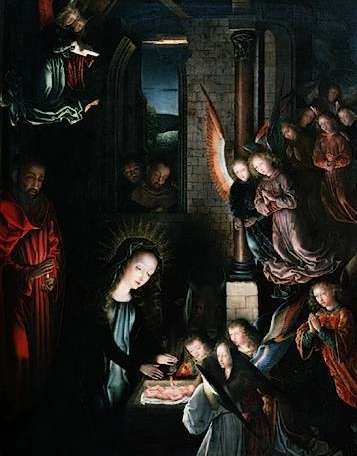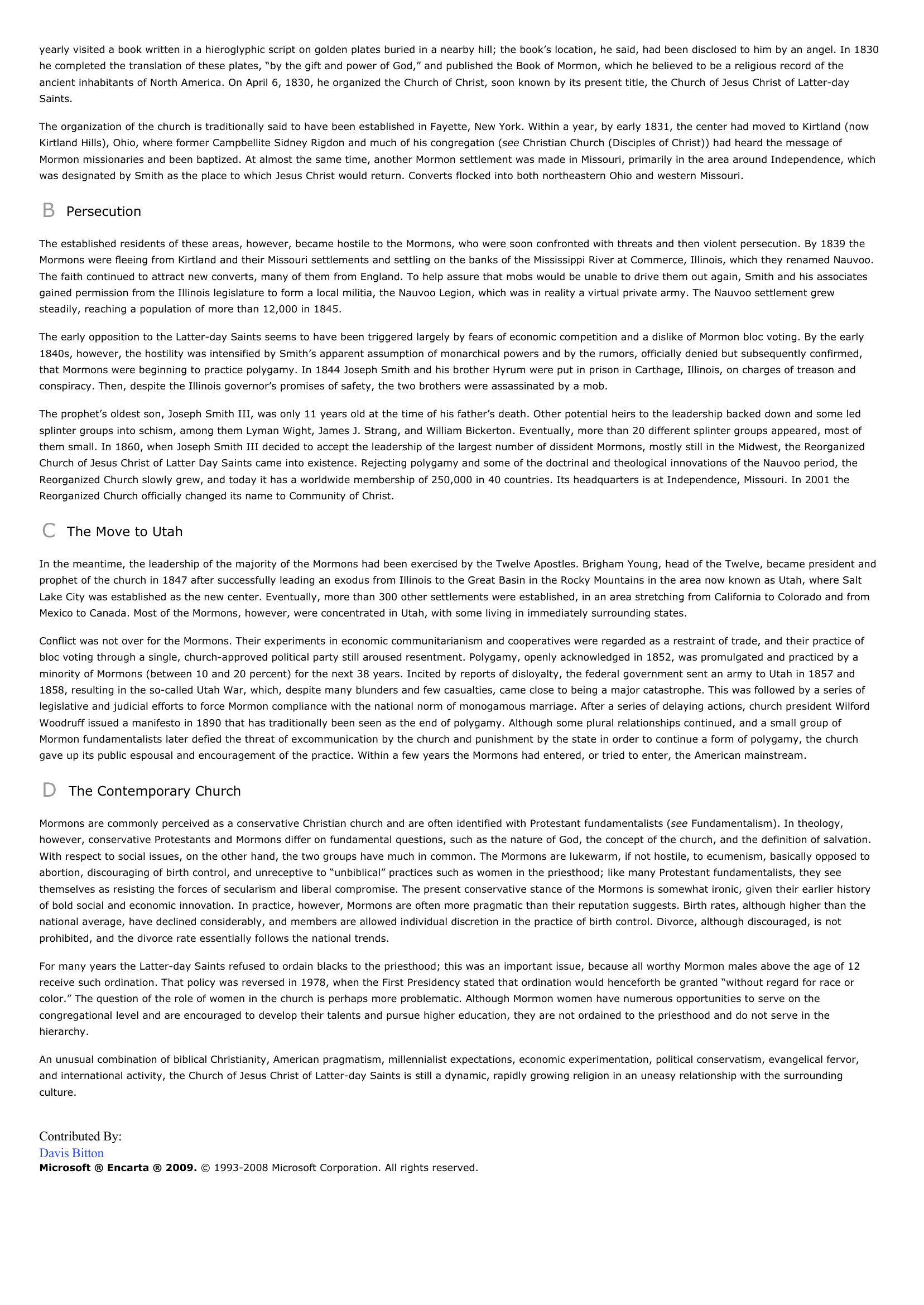Church of Jesus Christ of Latter-day Saints.
Publié le 10/05/2013

Extrait du document


«
yearly visited a book written in a hieroglyphic script on golden plates buried in a nearby hill; the book’s location, he said, had been disclosed to him by an angel.
In 1830he completed the translation of these plates, “by the gift and power of God,” and published the Book of Mormon, which he believed to be a religious record of theancient inhabitants of North America.
On April 6, 1830, he organized the Church of Christ, soon known by its present title, the Church of Jesus Christ of Latter-daySaints.
The organization of the church is traditionally said to have been established in Fayette, New York.
Within a year, by early 1831, the center had moved to Kirtland (nowKirtland Hills), Ohio, where former Campbellite Sidney Rigdon and much of his congregation ( see Christian Church (Disciples of Christ)) had heard the message of Mormon missionaries and been baptized.
At almost the same time, another Mormon settlement was made in Missouri, primarily in the area around Independence, whichwas designated by Smith as the place to which Jesus Christ would return.
Converts flocked into both northeastern Ohio and western Missouri.
B Persecution
The established residents of these areas, however, became hostile to the Mormons, who were soon confronted with threats and then violent persecution.
By 1839 theMormons were fleeing from Kirtland and their Missouri settlements and settling on the banks of the Mississippi River at Commerce, Illinois, which they renamed Nauvoo.The faith continued to attract new converts, many of them from England.
To help assure that mobs would be unable to drive them out again, Smith and his associatesgained permission from the Illinois legislature to form a local militia, the Nauvoo Legion, which was in reality a virtual private army.
The Nauvoo settlement grewsteadily, reaching a population of more than 12,000 in 1845.
The early opposition to the Latter-day Saints seems to have been triggered largely by fears of economic competition and a dislike of Mormon bloc voting.
By the early1840s, however, the hostility was intensified by Smith’s apparent assumption of monarchical powers and by the rumors, officially denied but subsequently confirmed,that Mormons were beginning to practice polygamy.
In 1844 Joseph Smith and his brother Hyrum were put in prison in Carthage, Illinois, on charges of treason andconspiracy.
Then, despite the Illinois governor’s promises of safety, the two brothers were assassinated by a mob.
The prophet’s oldest son, Joseph Smith III, was only 11 years old at the time of his father’s death.
Other potential heirs to the leadership backed down and some ledsplinter groups into schism, among them Lyman Wight, James J.
Strang, and William Bickerton.
Eventually, more than 20 different splinter groups appeared, most ofthem small.
In 1860, when Joseph Smith III decided to accept the leadership of the largest number of dissident Mormons, mostly still in the Midwest, the ReorganizedChurch of Jesus Christ of Latter Day Saints came into existence.
Rejecting polygamy and some of the doctrinal and theological innovations of the Nauvoo period, theReorganized Church slowly grew, and today it has a worldwide membership of 250,000 in 40 countries.
Its headquarters is at Independence, Missouri.
In 2001 theReorganized Church officially changed its name to Community of Christ.
C The Move to Utah
In the meantime, the leadership of the majority of the Mormons had been exercised by the Twelve Apostles.
Brigham Young, head of the Twelve, became president andprophet of the church in 1847 after successfully leading an exodus from Illinois to the Great Basin in the Rocky Mountains in the area now known as Utah, where SaltLake City was established as the new center.
Eventually, more than 300 other settlements were established, in an area stretching from California to Colorado and fromMexico to Canada.
Most of the Mormons, however, were concentrated in Utah, with some living in immediately surrounding states.
Conflict was not over for the Mormons.
Their experiments in economic communitarianism and cooperatives were regarded as a restraint of trade, and their practice ofbloc voting through a single, church-approved political party still aroused resentment.
Polygamy, openly acknowledged in 1852, was promulgated and practiced by aminority of Mormons (between 10 and 20 percent) for the next 38 years.
Incited by reports of disloyalty, the federal government sent an army to Utah in 1857 and1858, resulting in the so-called Utah War, which, despite many blunders and few casualties, came close to being a major catastrophe.
This was followed by a series oflegislative and judicial efforts to force Mormon compliance with the national norm of monogamous marriage.
After a series of delaying actions, church president WilfordWoodruff issued a manifesto in 1890 that has traditionally been seen as the end of polygamy.
Although some plural relationships continued, and a small group ofMormon fundamentalists later defied the threat of excommunication by the church and punishment by the state in order to continue a form of polygamy, the churchgave up its public espousal and encouragement of the practice.
Within a few years the Mormons had entered, or tried to enter, the American mainstream.
D The Contemporary Church
Mormons are commonly perceived as a conservative Christian church and are often identified with Protestant fundamentalists ( see Fundamentalism).
In theology, however, conservative Protestants and Mormons differ on fundamental questions, such as the nature of God, the concept of the church, and the definition of salvation.With respect to social issues, on the other hand, the two groups have much in common.
The Mormons are lukewarm, if not hostile, to ecumenism, basically opposed toabortion, discouraging of birth control, and unreceptive to “unbiblical” practices such as women in the priesthood; like many Protestant fundamentalists, they seethemselves as resisting the forces of secularism and liberal compromise.
The present conservative stance of the Mormons is somewhat ironic, given their earlier historyof bold social and economic innovation.
In practice, however, Mormons are often more pragmatic than their reputation suggests.
Birth rates, although higher than thenational average, have declined considerably, and members are allowed individual discretion in the practice of birth control.
Divorce, although discouraged, is notprohibited, and the divorce rate essentially follows the national trends.
For many years the Latter-day Saints refused to ordain blacks to the priesthood; this was an important issue, because all worthy Mormon males above the age of 12receive such ordination.
That policy was reversed in 1978, when the First Presidency stated that ordination would henceforth be granted “without regard for race orcolor.” The question of the role of women in the church is perhaps more problematic.
Although Mormon women have numerous opportunities to serve on thecongregational level and are encouraged to develop their talents and pursue higher education, they are not ordained to the priesthood and do not serve in thehierarchy.
An unusual combination of biblical Christianity, American pragmatism, millennialist expectations, economic experimentation, political conservatism, evangelical fervor,and international activity, the Church of Jesus Christ of Latter-day Saints is still a dynamic, rapidly growing religion in an uneasy relationship with the surroundingculture.
Contributed By:Davis BittonMicrosoft ® Encarta ® 2009. © 1993-2008 Microsoft Corporation.
All rights reserved..
»
↓↓↓ APERÇU DU DOCUMENT ↓↓↓
Liens utiles
- Jesus Christ I INTRODUCTION Jesus Christ (between 8 and 4 BC-AD 29?
- Jesus Christ.
- Il n'en est pas de-même de Jesus Christ, qui propose sa croix au coeur et à l'esprit des hommes, comme un paradoxe étonnant, et comme une source de mortification et de repentance. ? Jacques Abbadie, Traité de la vérité de la religion chrétienne, vol. 2
- 179085 ICÔNE Image peinte représentant le Christ, la Vierge Marie, des anges et des saints.
- PORCHE À LA NUIT DES SAINTS de Pierre-Jean Jouve (résumé & analyse)










